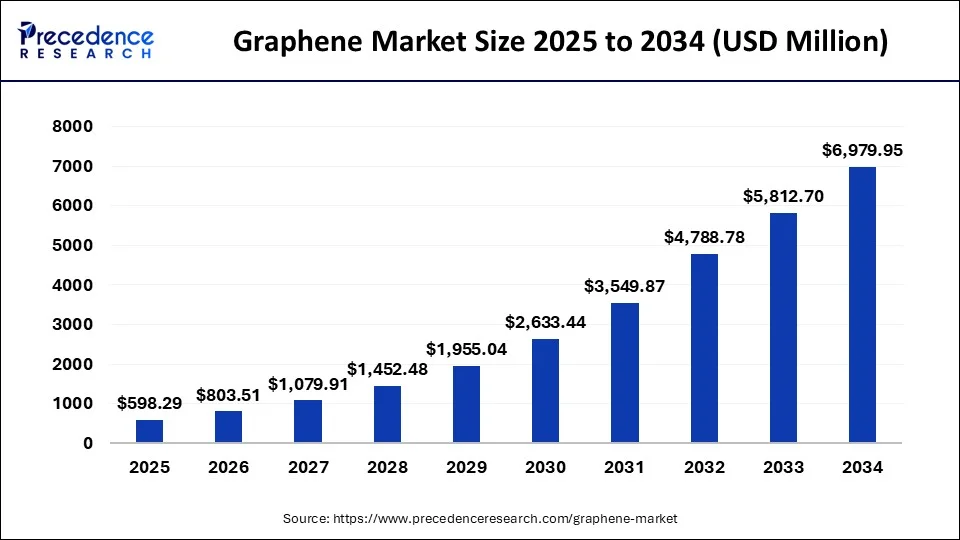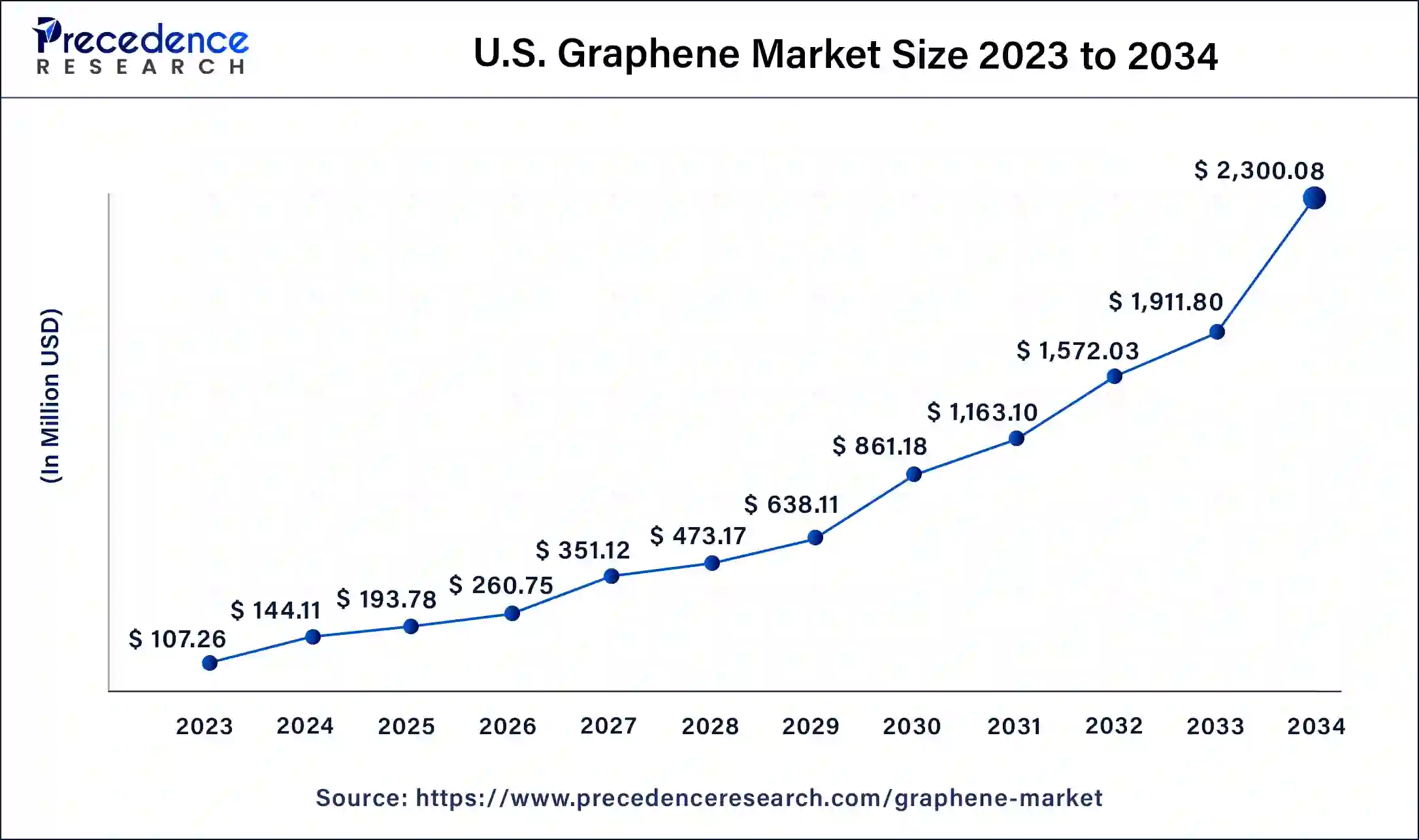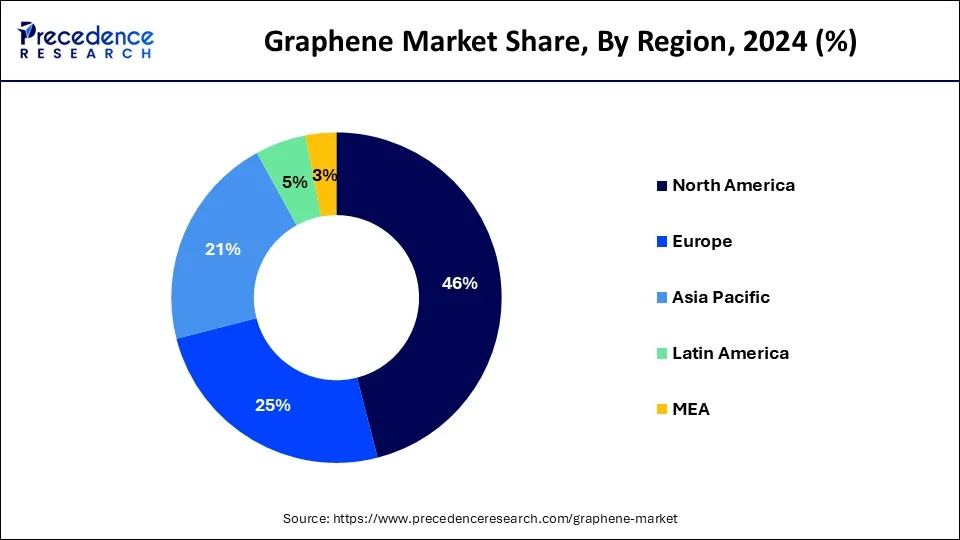What is the Graphene Market Size?
The global graphene market size was calculated at USD 598.29 million in 2025, accounted for USD 803.51 million in 2026, and is expected to reach around USD 6,979.95 million by 2034, expanding at a CAGR of 31.70% from 2025 to 2034. The North America graphene market size reached USD 152.93 million in 2023.

Market Highlights
- North America contributed more than 46% of revenue share in 2024.
- Europe is estimated to expand the fastest CAGR between 2025 and 2034.
- By product type, the graphene nanoplatelets segment has held the largest market share of 59% in 2024.
- By product type, the Graphene Oxide (GO) segment is anticipated to grow at a remarkable CAGR of 38.1% between 2024 and 2034.
- By end-user, the composites segment had the largest market share of 52% in 2024.
- By end-user, the energy segment is expected to expand at the fastest CAGR over the projected period.
Market Size and Forecast
- Market Size in 2025: USD 598.29 Billion
- Market Size in 2026: USD 803.51 Billion
- Forecasted Market Size by 2034: USD 6,979.95 Billion
- CAGR (2025-2034): 31.70%
- Largest Market in 2024: North America
- Fastest Growing Market: Europe
Market Overview
The graphene market revolves around the material graphene, a single layer of carbon atoms arranged in a hexagonal lattice. This advanced material exhibits remarkable properties, including exceptional strength, electrical, and thermal conductivity. As a versatile nanomaterial, graphene holds immense potential for innovations and advancements in diverse technological domains, driving research, development, and commercial activities in the global graphene market.
Graphene, hailed as a "wonder material," finds applications in flexible electronics, high-performance batteries, conductive inks, and advanced coatings. Its unique properties, such as transparency, flexibility, and strength, contribute to its widespread adoption across industries, fostering continuous exploration of its potential in emerging technologies and fostering a dynamic landscape in the graphene market. The market involves graphene's production, application, and commercialization across various industries such as electronics, energy, automotive, and healthcare.
Graphene Market Growth Factors
- Material Innovation: Graphene's exceptional properties, including high electrical conductivity and mechanical strength, drive its demand for applications in electronics, energy storage, and materials science.
- Electronic Devices: Increasing integration of graphene in flexible electronics, transparent conductive films, and high-performance devices stimulates market growth.
- Energy Storage: Graphene's role in enhancing battery performance and supercapacitors contributes to advancements in energy storage solutions.
- Materials Science: Ongoing research explores graphene's potential in advanced materials, composites, and coatings, fostering innovation in multiple industries.
- Medical Applications: Graphene's biocompatibility and conductivity drive exploration in medical devices, sensors, and drug delivery systems.
- Strategic Collaborations: Collaborative efforts between research institutions and industry players accelerate graphene application development.
- Government Initiatives: Supportive government initiatives and funding for graphene research foster technological advancements and market expansion.
- Sustainable Technologies: Growing emphasis on sustainable and eco-friendly solutions boosts graphene's adoption in various applications.
- Market Competition: Increasing competition among key players promotes technological advancements and diversified applications.
- Emerging Industries: Graphene's versatility creates opportunities in emerging industries like quantum computing, photonics, and sensors.
- Aerospace Applications: Graphene's lightweight nature and mechanical strength make it an attractive material for aerospace components, leading to advancements in aviation technology.
- Automotive Sector: Graphene's lightweight and strong properties contribute to the development of advanced materials for automotive applications, including lightweight composites and conductive coatings.
- Consumer Electronics: Integration of graphene in electronic gadgets, displays, and wearables enhances device performance and durability.
- Water Filtration: Graphene-based membranes show promise in water purification, offering improved filtration efficiency.
- Environmental Monitoring: Graphene sensors find applications in environmental monitoring systems for detecting pollutants and gases.
- Smart Textiles: Incorporating graphene into fabrics creates smart textiles with properties like conductivity and flexibility for wearable technology.
- Sports Equipment: Graphene-reinforced materials enhance the strength and performance of sports equipment like racquets and bicycles.
- Military Applications: Graphene's strength and versatility make it valuable for military applications, including lightweight armor and sensor technologies.
- Healthcare Innovations: Graphene-based materials are explored for innovative solutions in drug delivery, tissue engineering, and medical imaging.
- Space Exploration: Graphene's unique properties make it a candidate for space applications, such as lightweight components for satellites.
Major Key Trends in Graphene Market
- Innovations in Energy Storage Solutions: Graphene's exceptional conductivity and extensive surface area are improving lithium-ion batteries and supercapacitors, enabling quicker charging, higher capacity, and prolonged lifespans, essential for electric vehicles and portable gadgets.
- Growth in Flexible and Wearable Technologies: Because of its flexibility and transparency, graphene is being incorporated into foldable smartphones, wearable gadgets, and flexible displays, satisfying the increasing demand for cutting-edge consumer electronics.
- Expansion in Biomedical Uses: Graphene's biocompatibility and antibacterial features are propelling its application in biosensors, drug delivery systems, and medical implants, facilitating advancements in diagnostics and personalized healthcare.
- Inclusion in Sustainable Building Materials: Integrating graphene into concrete and coatings improves strength and longevity, resulting in infrastructure that lasts longer and has a reduced environmental footprint in the construction sector.
Market Scope
| Report Coverage | Details |
| Market Size by 2025 | USD 598.29 Million |
| Market Size in 2026 | USD 803.51 Million |
| Market Size in 2034 | USD 6,979.95 Million |
| Growth Rate from 2025 to 2034 | CAGR of 31.70% |
| Largest Market | North America |
| Base Year | 2025 |
| Forecast Period | 2025 to 2034 |
| Segments Covered | Product Type, End-user and Region |
| Regions Covered | North America, Europe, Asia-Pacific, Latin America, and Middle East & Africa |
Market Dynamics
Drivers
Material advancements, automotive surge and energy storage solutions
Material advancements and breakthroughs in graphene applications have played a pivotal role in surging market demand. Graphene, with its exceptional characteristics such as high electrical conductivity, mechanical strength, and flexibility, has become a compelling material across diverse industries. Ongoing advancements in the creation of graphene-based composites, coatings, and functional materials have broadened its applications in key sectors, including electronics, aerospace, and healthcare. This continual innovation underscores graphene's versatility and positions it as a transformative element driving progress and applications in multiple industries.
Graphene has emerged as a crucial driver in the energy sector, particularly in energy storage solutions. The utilization of graphene in batteries and supercapacitors has showcased outstanding performance attributes, including accelerated charging times and heightened energy density. With the increasing demand for efficient and sustainable energy storage solutions, the significance of graphene in elevating the performance of these devices has grown substantially. This dynamic contribution positions graphene as a key catalyst propelling the market forward in response to the evolving needs of the energy industry. The ongoing pursuit of innovative graphene applications and its integration into emerging technologies contribute to sustained market expansion.
In the automotive sector, graphene's lightweight and robust characteristics make it a sought-after material for advancing vehicle technologies. The integration of graphene into automotive components, such as lightweight composites and conductive coatings, enhances overall vehicle performance, fuel efficiency, and durability. As the automotive industry continues to prioritize lightweight and innovative materials, graphene plays a crucial role in driving advancements, making vehicles more efficient, sustainable, and technologically advanced.
Restraint
Production challenges and regulatory hurdles
The graphene market faces challenges related to production processes. Scaling up graphene production to meet commercial demands remains a significant hurdle. The intricate methods for producing high-quality graphene in large quantities involve complex techniques like chemical vapor deposition or liquid-phase exfoliation. These processes encounter difficulties in achieving consistent quality, hampering mass production. Additionally, the cost-effectiveness of large-scale production remains a concern, impacting the overall accessibility of graphene-based products.
Regulatory hurdles also pose challenges. The nanoscale nature of graphene raises safety and environmental concerns, necessitating clear regulatory frameworks. Uncertainty in regulatory standards and the absence of universally accepted guidelines hinder the seamless integration of graphene into various industries. Addressing these challenges requires collaboration between industry stakeholders, regulatory bodies, and research institutions to establish standardized production methods and comprehensive safety regulations, ensuring the sustainable growth of the graphene market.
Opportunity
Medical applications, electronic devices and wearables
Graphene's unique properties enable the development of smaller, faster, and more energy-efficient electronic components. It serves as a promising material for next-generation transistors, conductive inks, and flexible displays. As consumer electronics continue to evolve, incorporating graphene into the manufacturing processes contributes to enhanced device performance and durability. The electronics and semiconductor industry's increasing reliance on graphene reflects the material's pivotal role in advancing technological capabilities and meeting the escalating demands for more sophisticated and efficient electronic products.
Moreover, the demand for graphene is amplified by its incorporation into electronic devices and wearables. The increasing integration of graphene into consumer electronics and wearables propels market demand, reflecting the material's pivotal role in advancing technological innovation.
Additionally, the lightweight and flexible nature of graphene contributes to advancements in wearable technology, leading to the development of thinner, lighter, and more durable devices. The growing consumer preference for innovative and high-performance electronics fuels the demand for graphene in this market segment.
Segments Insights
Product Type Insights
According to the product type, the graphene nanoplatelets segment has held a 59% revenue share in 2024. Graphene Nanoplatelets (GNPs) are two-dimensional nanomaterials consisting of multiple graphene layers. These platelets exhibit excellent thermal and electrical conductivity, making them valuable in various applications. The trend in the Graphene market for GNPs involves their utilization in composites, coatings, and energy storage devices. Their large surface area and mechanical strength contribute to enhanced material properties, leadig to increased demand in industries seeking advanced materials for improved performance.
The Graphene Oxide (GO) segment is anticipated to expand at a significantly CAGR of 38.1% during the projected period. Graphene Oxide (GO) is a derivative of graphene, featuring oxygen-containing functional groups. GO exhibits unique properties, including good water dispersibility and tunable surface chemistry. In the Graphene market, the trend for graphene oxide involves its use in biomedical applications, sensors, and energy storage. The functional groups make it suitable for applications like drug delivery systems and biosensors. The evolving trends in both Graphene Nanoplatelets and Graphene Oxide highlight their versatility and applicability across diverse industries, driving innovation in materials science and technology.
End-user Insights
In2024, the composites segment had the highest market share of 52% based on the end user. Graphene, as a key component in composite materials, is revolutionizing various industries. In composites, graphene enhances mechanical strength, conductivity, and thermal properties. The aerospace sector is increasingly adopting graphene composites for lightweight, strong materials, improving fuel efficiency. Automotive and construction industries also leverage graphene composites for durable and high-performance components, contributing to the trend of developing advanced materials with superior properties.
The energy segment is anticipated to expand at the fastest rate over the projected period. In the energy sector, graphene plays a pivotal role in advancing battery technology and energy storage. Graphene batteries offer higher energy density, faster charging times, and longer lifespan compared to traditional batteries. This trend is particularly prominent in electric vehicles and portable electronic devices.
Additionally, graphene-based supercapacitors are gaining traction for their quick charging capabilities. The energy sector's adoption of graphene aligns with the broader trend of seeking more efficient and sustainable solutions in power storage and utilization.
Regional Insights
U.S. Graphene Market Size and Growth 2025 to 2034
The U.S. graphene market size was estimated at USD 193.78 million in 2025 and is predicted to be worth around USD 2,300.08 million by 2034, at a CAGR of 31.90% from 2025 to 2034.

North America has held the largest revenue share 46% in 2024. The graphene market in North America is witnessing substantial growth, driven by robust investments in research and development, particularly in the United States. The region's advanced technological infrastructure and focus on innovation contribute to the adoption of graphene in various industries. Collaborations between academic institutions, research organizations, and industry players further propel the development and commercialization of graphene-based products, creating a dynamic market landscape.
As the automotive industry continues to prioritize lightweight and innovative materials, graphene plays a crucial role in driving advancements, making vehicles more efficient, sustainable, and technologically advanced.

Europe is estimated to observe the fastest expansion. Europe is at the forefront of graphene research and commercialization. The European Union has invested significantly in graphene-related projects, fostering a dynamic market. Research institutions and industries in countries like the United Kingdom and Germany are actively exploring graphene's potential across various sectors, including electronics, automotive, and energy storage. Government initiatives and a supportive innovation ecosystem position Europe as a key player in the global graphene market.
Asia-Pacific is a key player in the global graphene market, marked by substantial growth in countries like China, Japan, and South Korea. Robust industrialization, coupled with a focus on emerging technologies, fuels the demand for graphene in applications ranging from electronics to energy storage. Government initiatives supporting graphene research, coupled with a thriving electronics sector, contribute to the region's prominence in driving advancements and innovation in the graphene market.
Graphene Market Companies
- Graphenea S.A.
- Haydale Graphene Industries plc
- Versarien plc
- Grafoid Inc.
- XG Sciences
- Applied Graphene Materials Plc
- G6 Materials Corp.
- NanoXplore Inc.
- Directa Plus plc
- Talga Resources Ltd
- Graphene NanoChem plc
- Angstron Materials Inc.
- Vorbeck Materials Corp.
- Applied Nanotech Inc.
- NanoMaterials Ltd.
Recent Developments
- In October 2024, The Italian startup BeDimensional has secured USD 22.2 million from the European Investment Bank to expand its graphene production capabilities. The funding will aid in the establishment of a new facility in Genoa, with the goal of increasing annual output from over 3 tonnes to more than 30 tonnes by 2028, in line with the EU's plan to decrease dependence on critical material imports.
- In October 2024, South Korea's Graphene Square has unveiled a cordless, transparent cooker that utilizes graphene heating elements, consuming just 600 watts half the energy of conventional cookers. Supported by an USD 11.3 million investment from Samsung, the company intends to begin pilot production at its new facility in Pohang by late 2024, representing a notable step forward in energy-efficient cooking technology.
- In June 2024, In the framework of the European Sunshine initiative, Avanzare and Tecnalia have created a digital twin system equipped with sensors to track and minimize operator exposure to graphene particles during production. This project aims to implement Safe and Sustainable by Design (SSbD) strategies, promoting safer manufacturing practices within the graphene sector.
- In 2023, Universal Matter UK Limited, owned subsidiary of Universal Matter Inc., acquired Applied Graphene Materials UK Limited and Applied Graphene Materials LLC, the principal operating subsidiaries of Applied Graphene Materials PLC. This strategic move aims to enhance Universal Matter's market presence and capabilities in the graphene materials sector, fostering growth and innovation in the industry.
- In 2020, Graphenea SA expanded its GEFT sensing product line with the introduction of two new graphene-based sensors, S11 and S12. This product launch signifies Graphenea's commitment to innovation and the enhancement of its graphene-based sensor offerings, contributing to the company's growth in this market segment.
- In 2020,NanoXplore Inc. expanded its presence in the U.S. through the acquisition of Continental Structural Plastics, facilitated by its subsidiary RMC Advanced Technologies Inc. This strategic move not only provided NanoXplore with a foothold in the U.S. market but also presented opportunities for the company to enhance its marketing efforts and boost graphene sales.
Segments Covered in the Report
By Product Type
- Graphene Nanoplatelets
- Graphene Oxide
- Reduced Graphene Oxide
- Other Product Types
By End-user
- Electronics and Telecommunication
- Composites
- Energy
- Aerospace and Defense
- Other End-user Industries
By Region
- North America
- Europe
- Asia-Pacific
- Latin America
- Middle East and Africa
For inquiries regarding discounts, bulk purchases, or customization requests, please contact us at sales@precedenceresearch.com
Frequently Asked Questions
Ask For Sample
No cookie-cutter, only authentic analysis – take the 1st step to become a Precedence Research client
 sales@precedenceresearch.com
sales@precedenceresearch.com
 +1 804-441-9344
+1 804-441-9344